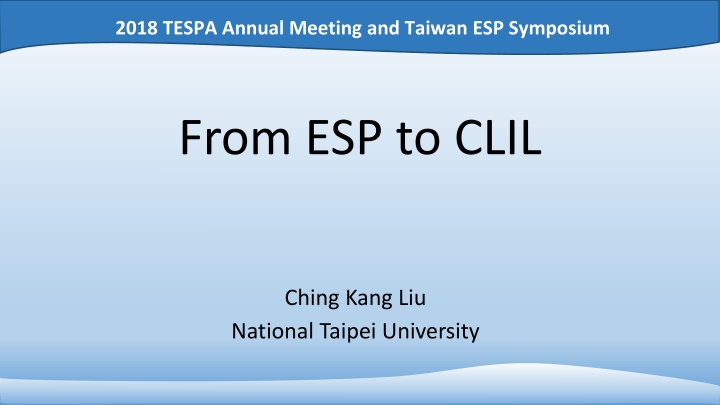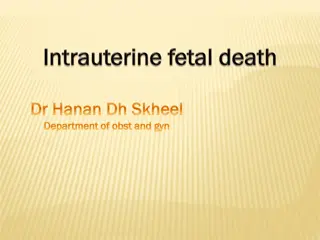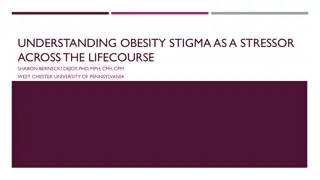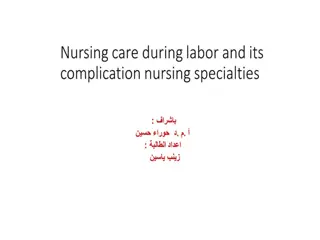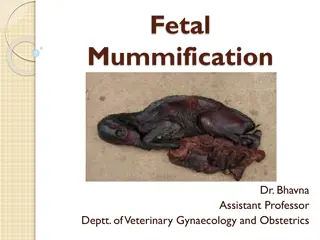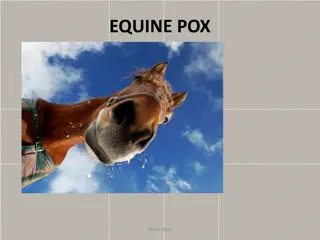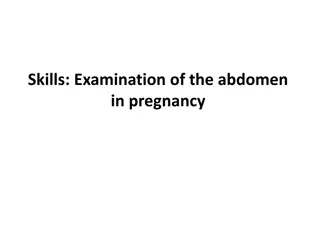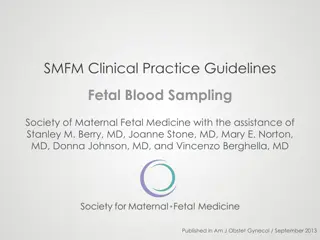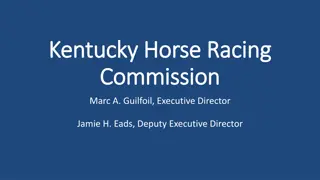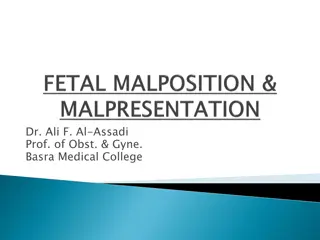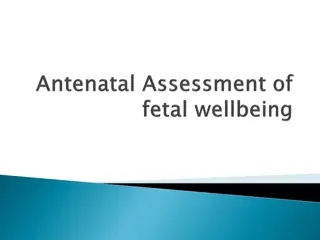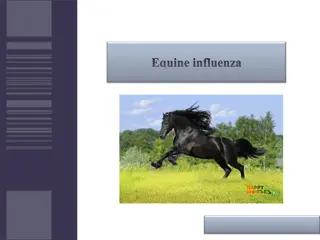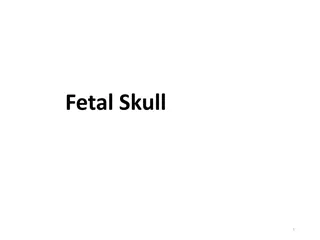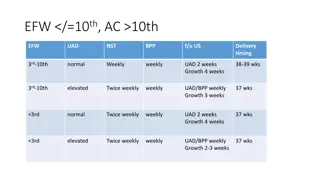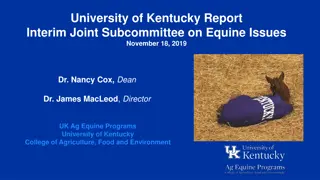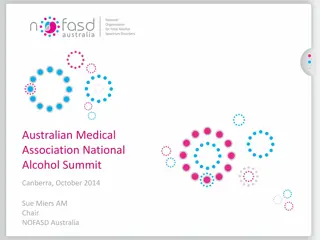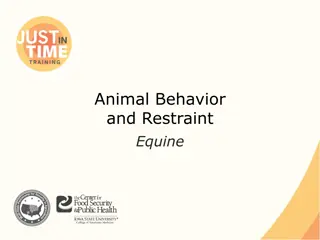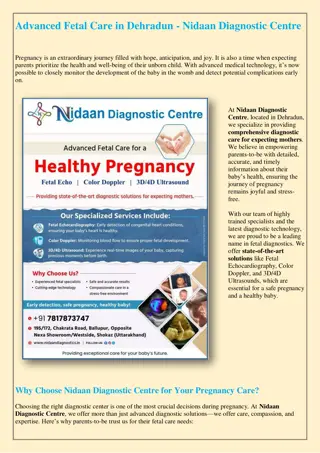Equine NIPT Development for Fetal Aneuploidy Detection
Development of a non-invasive diagnostic test for dual detection of fetal aneuploidy and fetal sex in pregnant mares, offering benefits such as diagnosing aneuploid pregnancies and lethal genetic variants, as well as allowing non-invasive sex determination of the fetus. Challenges include sparse knowledge and lack of established techniques for cfDNA isolation in horses.
Download Presentation

Please find below an Image/Link to download the presentation.
The content on the website is provided AS IS for your information and personal use only. It may not be sold, licensed, or shared on other websites without obtaining consent from the author.If you encounter any issues during the download, it is possible that the publisher has removed the file from their server.
You are allowed to download the files provided on this website for personal or commercial use, subject to the condition that they are used lawfully. All files are the property of their respective owners.
The content on the website is provided AS IS for your information and personal use only. It may not be sold, licensed, or shared on other websites without obtaining consent from the author.
E N D
Presentation Transcript
2018 TESPA Annual Meeting and Taiwan ESP Symposium From ESP to CLIL Ching Kang Liu National Taipei University
Overview 1.Challenges of ESP programs in Taiwan 2.What should be included in CLIL? 3.Challenges for promoting CLIL in Taiwan 2/28/2025 2
Why ESP? 1. The demands of the global economic development in the 20th century. 2. New findings regarding English used in different disciplines/genres 1) Barber (1962) reported the nature of scientific English 2) English for Science and Technology (EST) was largely studied in the 1970s (Ewer & Latorre 1969; Swales, 1971; Lelinker & Trimble, 1976, etc.) and doctor-patient communication by Candlin, Bruton & Leather (1976) 3. The awareness of why do English learners need to learn English? 4. Perhaps ESP is an option that can help those who fail in EGP classes 2/28/2025 3
What should be included in ESP? Hohn Munby s Communicative Syllabus Design (1978) for Needs Analysis. Munby presents a highly detailed set of procedures for discovering target situation needs. He calls this set of procedures the Communication Needs Processor (CNP). CNP consists of a range of questions about key communication variables (topic, participants, medium, etc.) which can be used to identify the target language needs of any group of learners. 2/28/2025 4
What should be included in ESP? Hutchinson & Waters Definition: ESP should properly be seen not as any particular language product but as an approach to language teaching in which all decisions as to content and method are based on the learner s reason of learning. (Hutchinson & Waters, 1987:19) 2/28/2025 5
What should be included in ESP? Strevens definition: 4 absolute characteristics and 2 variable characteristics The 4 absolute characteristics consists of English Language Teaching - designed to meet specified needs of the learners; - related in content (that is in theme and topics) to particular disciplines, occupations and activities; - centered on language appropriate to those activities in syntax, lexis, discourse, semantics and so on, and analysis of the discourse; - in contrast with general English. (Streven, 1988) 2/28/2025 6
What should be included in ESP? Strevens definition: 2 variable characteristics -May be restricted as to the learning skills to be learned (for example, reading only); -May not be taught according to any pre-ordained methodology. (Streven, 1988) 2/28/2025 7
What should be included in ESP? Dudley Evans & St John s definition: 3 absolute characteristics and 4 variable characteristics The three absolute characteristics: - ESP is designed to meet specific needs of the learner; - ESP makes use of the underlying methodology and activities of the disciplines it serves; - ESP is centered on the language (grammar, lexis, register), skills, discourses and genres appropriate to these activities. (Dudley-Evans & St John, 1998) 2/28/2025 8
What should be included in ESP? Dudley Evans & St John s definition: 4 variable characteristics: - ESP may be related to or designed for specific disciplines; - ESP may use, in specific teaching situations, a different methodology from that of general English; - ESP is likely to be designed for adult learners, either at a tertiary level institution or in a professional work situation. It could, however, be used for learners at secondary school level; - ESP is generally designed for intermediate or advanced students. Most ESP courses assume basic knowledge of the language system, but it can be used with beginners. (Dudley-Evans & St John, 1998) 2/28/2025 9
What should be included in ESP? ESP should focus primarily on specific language, skills, and genres of particular disciplines. (Hyland, 2002) The language and learning objectives for ESP include - Analytical skills; - problems-solving skills; - Negotiation skills; - teamwork-based discover[y] learning skills; - The ability to learn how to learn. (Anthony, L., 2017) 2/28/2025 10
What should be included in ESP? Anthony s definition: English for Specific Purposes (ESP) is an approach to language teaching that targets the current and/or future academic or occupational needs of learners, focuses on the necessary language, genres, and skills to address these needs, and assists learners in meeting these needs through the use of general and/or specialist field teaching materials and methods. (Anthony, L., 2018) 2/28/2025 11
Continuum of ELT course types (from ELT to ESP) a presentation of the whole of English language teaching on a continuum that runs from clearly definable General English courses through to every specific ESP courses (Dudley-Evans & St John, 1998: p. 9) Dudley-Evans & St John s (1998) continuum EGSP EGP EMI ESP GENERAL SPECIFIC ? Position I Position 2 Position 4 Position 3 Position 5 English for beginners Intermediate to advanced EGP courses with a focus on particular skills Courses for broad disciplinary or professional areas, for example, Report Writing for Scientists and Engineers, Medical English, Legal English, Negotiation/Meeting Skills for Business People EGAP/EGBP courses based on common-core language and skills not related to specific disciplines or professions 1) An academic support course related to a particular academic course; 2) One-to-one work with business people ? 2/28/2025 12
Challenges of ESP courses in Taiwan EGP EGSP/ESP EMI Teachers More sufficient Less sufficient / rare Rare Methods/strategies Richer still exploring / in variety Same still exploring / various for different courses Assessment more reliable & valid options Same Limited textbooks / authentic materials Materials rich for different levels Textbooks in English to build general proficiency (all); for the tests literacy in one specific domain (adults?); for careers/practice Content knowledge; for career/practice Purpose Same (< 10%) Expected outcome Improving Difficult to evaluate Motivation In variety Generally high Low 2/28/2025 13
Why Content & Language Integrated Learning (CLIL)? 1. New Taipei City: From immersion program to CLIL 2. Tainan City: The former Mayor Lai, Ching-ti tried to promote CLIL for the purpose of EASOL. Premier Lai just announced that, by 2030, Taiwan will be a bilingual country. 3. Taipei City: CLIL as an experimental program 2/28/2025 14
What should be included in CLIL? CLIL is a dual-focused educational approach in which an additional language is used for the learning and teaching of both content and language. (Mehisto, Marsh, & Frigols, 2008: p. 9; Coyle, Hood, and Marsh, 2010, p. 1) The term CLIL was launched in Europe in the 1990s and is often with teaching through the medium of English (Dalton-Puffer, Nikula, & Smit, 2010). 2/28/2025 15
What should be included in CLIL? Johnson and Swain (1997, pp. 6 8) identified, from the key features that define a prototypical immersion program, the features that describe the main characteristics of CLIL programs: (1) The L2 is the medium of instruction (2) Overt support exists for the L1 (3) Learners have a limited knowledge of the L2 (4) Teachers are sufficiently competent in L2 + subject/content (5) The L2 curriculum parallels the L1 curriculum (6) The classroom culture is that of the L1 community, not that of the L2 community. 2/28/2025 16
What should be included in CLIL? According to a report Improving the effectiveness of language learning: CLIL and computer assisted language learning (25 June 2014), The overall goals of CLIL can be wide-ranging but should include (Dalton-Puffer, 2007) 1.to develop intercultural communication skills; 2.to prepare for internationalism; 3.to provide opportunities to study content through different perspectives; 4.to access subject-specific target language terminology; 5.to improve overall target language competence; 6.to develop oral communication skills; 7.to diversify methods and forms of classroom practice; and 8.to increase learner motivation. 2/28/2025 17
What should be included in CLIL? The expectations of CLIL are often expressed as the 4C s Content: Integrating content from across the curriculum Cognition: creativity, higher order thinking, and knowledge processing Culture: Interpreting and understanding significance of language The 4C s (cited in Meyer, 2010; Ruiz De Zarobe, 2013) Communication: Mediating ideas, thoughts, and values 2/28/2025 18
What should be included in CLIL? The integration has a dual focus (Mehisto, Marsh & Frigols, 2008): (1) Language learning is included in content classes (e.g., math, history, geography, etc.). (2) Content from subjects is used in language-learning classes. The language teacher incorporates the vocabulary, terminology and texts from other subjects into his or her classes. 2/28/2025 19
What should be included in CLIL? CLIL advocates the obtaining of different knowledge and skills, according to what the subject is. It pays special attention to the development of academic skills that are determined by the age and cognitive and linguistic abilities of the students. It also emphasizes on the instruction of socio-cultural strategies, explicitly fostering activities which lead to the promotion of positive attitudes towards the speakers of the foreign language and towards their culture (Lantolf, 2000). 4C s 2/28/2025 20
What should be included in CLIL? The foci of language instruction in CLIL: 1. Comprehension (listening and reading) in a very specific range 2. Reproduction or production (speaking and writing) in a very specific range 3. Different formats and forms are used to enhance learners target language skills mainly related to the subject. 4. Language norms are limited to more mechanical discourse formats (in a subject) 2/28/2025 21
What should be included in CLIL? Content and Language Integrated Learning (CLIL) has a dual focus (Coyle et al, 2010) Met s (2009) continuum EMI ESP EGSP EGP Hard CLIL Soft CLIL Content-driven Language-driven EMI/Total immersion Sheltered course Adjunct model Theme- based Language classes with use of content for language practice Partial immersion 2/28/2025 22
What should be included in CLIL? Massler, Stotz, and Queisser (2014) differentiate two types of CLIL: Type A CLIL in subject lessons and type B CLIL language lessons. These types seem to be very close to what Met (1998) calls content-driven and language-driven ends of the continuum. Type A: 1. includes immersion, 2. takes place when learning aims are based on the content of the academic subject taught through the medium of a foreign language and 3. assessment is mainly based on content 2/28/2025 23
What should be included in CLIL? Type B: 1. refers to programs in which foreign language instruction is thematically based and 2. content from other school subjects is used in the language class. 3. In this case the aims and assessment focus on the foreign language. 4. This could be the case of some programs where CLIL is only limited to the foreign language class and curricular topics and projects, such as studying the human body or the solar system in the English language class. Massler et. al. (2014) also refer to a C type as a full integration of content and language shown in the pupils timetable as a subject of its own but consider that this is a rare phenomenon. When compared to Met s (1998) continuum, this seems to be the middle point between the two ends. 2/28/2025 24
Translanguaging A term first coined by Cen Williams (1994): the ability of multilingual speakers to shuttle between languages, treating the diverse languages that form their repertoire as an integrated system . Making use of translanguaging in the classroom does not require the teacher to be bilingual; however, it does require the teacher to be a co-learner (Garcia, 2014). 2/28/2025 25
What should be included in CLIL? Code-switching: One language as a major role and other languages are interrupting Translanguaging: Multiple languages work together to help students comprehend the content knowledge and help the students internalize the inputs in hope that they can share their ideas with others in at least one language (here we hope our students can comprehend the content knowledge using both Mandarin and English and can express their ideas in English). 2/28/2025 26
Some challenges for promoting CLIL in Taiwan 1. learning hours 2. Students English 3. Teachers English 4. teacher s willingness Mostly low 5. Methods/strategies Various for different subjects (scaffolding is a must) 6. Contents Usually too much for students if they want to learn English at the same time 7. Textbooks No textbooks available now (for any subjects) 8. Assessments Not aligned with those given in the other regular classes (either language or content classes) 9. Expected outcome Far shorter than expected Too limited both in teaching and learning Mostly poor (from grade school to college) Limited numbers of subject teachers are good 2/28/2025 27
2018 TESPA Annual Meeting and Taiwan ESP Symposium Thank you! 2/28/2025 28
